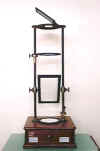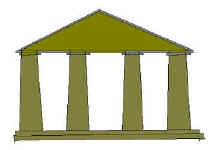

SM195
Norremberg’s Apparatus for polarisation of light
circa 1940 Light
When a ray of light falls on a polished, unsilvered glass surface at an
angle of 35o 25′, that is when the angle of incidence
is 54o 35′, it is reflected and the resultant ray is
polarised in the plane of reflection.
If the angle of incidence differs from this, the resultant ray is
only partially polarised.
This angle differs for various substances and the phenomenon
occurs where there is both reflection at the surface and refraction
through the medium.
Brewster discovered a simple law in reference to the polarising
angle:
The polarising angle of a substance is that angle of incidence for which
the reflected polarised ray is at right angles to the refracted ray.
Norremberg’s apparatus is used to polarise light by reflection.
Two brass rods support an unsilvered mirror that can rotate with
respect to the incident light.
Between the feet of the brass rods is a mirror of silvered glass
that is fixed and which transmits the polarised light vertically
upwards, passing through an aperture on top, where it meets a black
glass inclined to it at the polarising angle.
This can be rotated in a horizontal plane until a position is
found where the image in the black glass is cut off.
Placing slides containing materials that rotate the direction of
polarisation (many transparent minerals) between the crossed polarising
mirrors produces some interesting effects when the resultant ray of
light is viewed.

![]()
 Museum
Museum
![]()
![]()